A round up of reading and twitter threads I have fond useful to understand the stakes in the wave of protests around China triggered by news of the fire-deaths in Urumqi, Xijniang.
For news and images from China follow @whyyoutouzhele who is one of the most trusted sources of inside reports and footage from the protests.
Trust is a crucial issue because the internet is flooded with trolls and surveillance accounts that are either spreading disinformation or trawling for leads on behalf of China’s security services. Protests and vigils not just in China but around the world are being shadowed by Chinese security personnel. The Chinese diaspora is haunted by suspicion of surveillance and agent provocateurs.
On the story of how news of the urumqi fire victims spread through Chinese social media, this China Digital Times report is excellent. As the piece by Oliver Young describes it:
Enraged by the government’s censorship of criticisms about the Urumqi fire, one WeChat essayist wrote a satirical piece titled “Good, Good, Good, Good, Good, Good, Good: Good, Good, Good, Good, Good, Good, Good, Good, Good, Good, Good, Good, Good!” The body text mimicked the form of a normal WeChat essay, but replaced all the characters and images with the character “Good.” Although censors promptly deleted the essay, it sparked a round of creative imitation, with other netizens substituting various characters into the “Good” essay’s template. Many of these were also scrubbed by censors. CDT has translated a sample of the derivatives (and their comment sections) below:
The courage, imagination and dark humor of the protestors is inspiring.
As @tony_zy commented archly:
When police ask the protesters not to chant “no more lockdowns”, so they chant this instead: “MORE LOCKDOWNS!” “I WANT TO DO COVID TESTS!” Folks. Let me remind you this brave effort also encapsulates the highest Chinese wisdom: weaponized passive aggressiveness.
At Tsinghua University, students resorted to formulae:

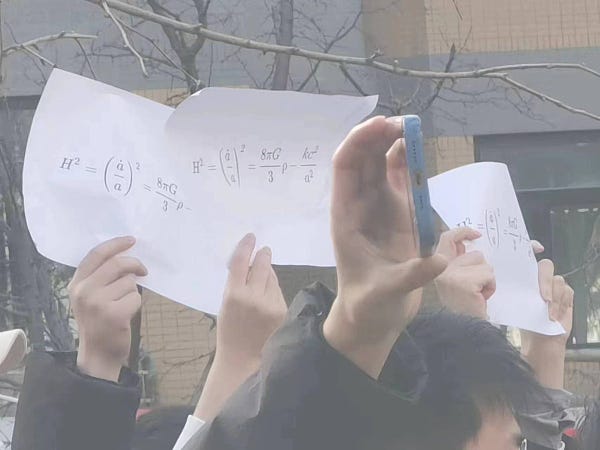
One of the myths about China is that it is such an oppressive regime that protests is unheard of. In fact, protests by workers, peasants, students and other groups occur relatively frequently and even brief acquaintance with China will impress you with how little respect is shown to regular uniformed police. The backchat and taunting of police is not as shocking as it might at first seem.
On the wider historical setting and the implications of the current protest wave this thread is excellent.

The trigger for the current wave of protests are the draconian zero COVID restrictions and the tragic consequences they have for ordinary people across China, the authoritarian spirit those measures articulate, and the way in which they have become identified with Xi and his personalistic conception of rule. But one trivializes the dilemma facing Beijing if one reduces this to a matter of Xi’s personal pride. The threat of a public health disaster is as real in China in 2022 as in China and the rest of the world in 2020. The disastrous dilemma that Beijing faces today is the result of the failure to contain the pandemic outside China in 2020 and 2021 and Beijing’s staggering failure to strengthen its own defenses against Omicron.


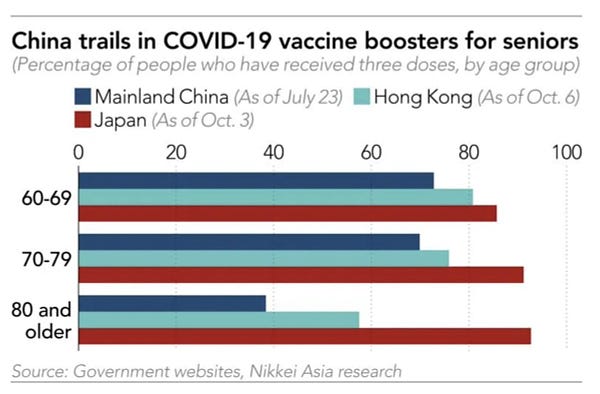


Hong Kong faced a similar challenge in early 2022 and the result was a public health disaster. Cumulative COVID mortality in Hong Kong surged to alarming levels.

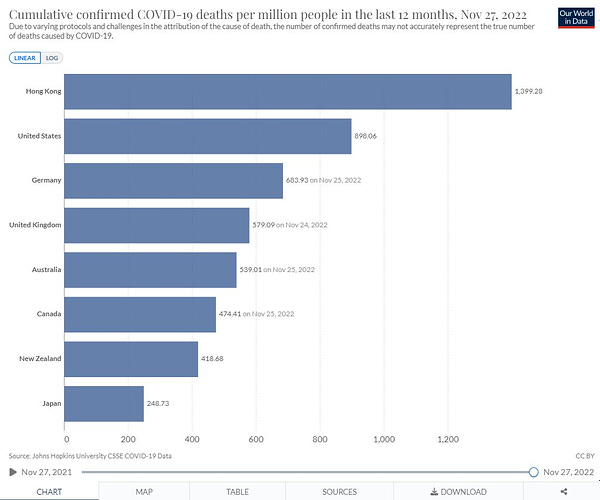
What is at stake here is not merely Xi’s obstinate insistence on his pedantic zero-COVID policy, but the question of whether Beijing is willing to consciously and publicly the distinct risk of a pandemic outbreak that will likely cause mass death and a fundamental challenge to China’s fragile health system. This would be a disaster for Xi and his narrative. But it would also be a disaster for China. It would be a return to the nightmare of Wuhan in February 2020, or New York in March 2020 and presumably Beijing would then be forced to respond with even more draconian lockdowns and a desperate fight to save its hospitals. Furthermore, with all the experience of the last two years in front of it and the disaster of Western policy widely advertised, Beijing would be accepting this national fiasco consciously. As Balloux says the situation is not one of caprice, but of disastrous impasse. There is no obvious escape strategy.
The only realistic option is a massively accelerated vaccination campaign aimed above all at the most resistant group i.e. the very elderly. That would perhaps create the breathing space for more selective and intelligent lockdown policies. In the mean time, the likelihood is that Beijing will continue with its current policy and respond to the protests by activating emergency plans for repression of “sudden public incidents”. On the repressive scenario planning of the regime, this by @hcsteinhardt is excellent.

As Steinhardt describes it in his 2020 article in Journal of Contemporary China “Defending Stability under Threat: Sensitive Periods and the Repression of Protest in Urban China”
… stability maintenance during sensitive periods appears much less rigid and more managerial than is often presumed. This points to a rather fine-tuned coercive apparatus in China’s urban centers. The state preempts some protests when it manages both previously known and sudden periods of sensitivity. Yet, it still tolerates a considerable amount of contention and avoids costly bouts of responsive repression even during periods when it perceives the political order as more vulnerable than usual.
Given the disastrous impasse Beijing faces and the likelihood of a crackdown to come, is there an alternative to despair?
On twitter two sorts of reflection on this theme have caught my eye. One cites the fabulously entitled essay about the shock of 1989 by Timur Kuran “Now out of Never. The Element of Surprise in the East European Revolution of 1989”


I was also reminded (h/t QW) of Lu Xun’s famous Preface to Call to Arms of 1922:

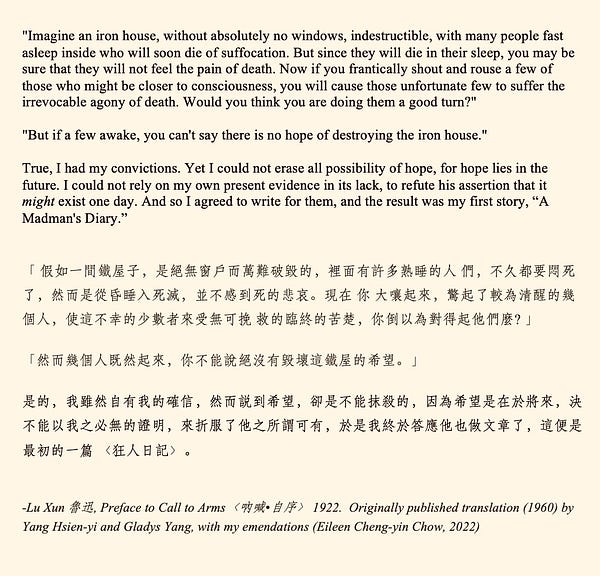
To sign up for Chartbook Newsletter click here





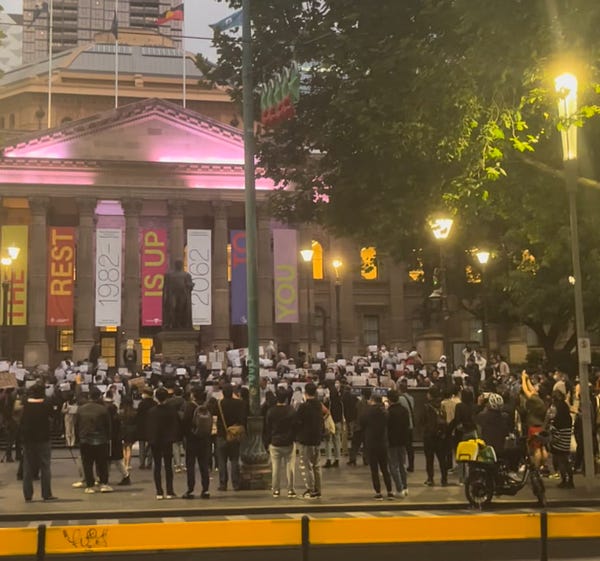
Thank you for this, very informative. I did not realize some of the things that I learned here about the Chinese people and their way of protest.
Pandemics kill people. Lockdowns defer that outcome, but achieve nothing else. The choice for Xi seems to be simply “when” the wave of deaths will happen - there is no “whether”.